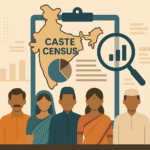Article 21 of Indian Constitution is one of the most important and powerful fundamental rights that protects the life and liberty of every person living in India. It simply means that no one can be deprived of their life or personal freedom unless the law allows it through a fair and just procedure.
In easy terms, Article 21 guarantees the right to live with dignity, safety, and respect under the law. Over time, the Supreme Court has interpreted this article broadly, saying that the right to life is not just the right to exist, but also the right to live a meaningful, healthy, and honourable life.
Article 21 of Indian Constitution states that “No person shall be deprived of his life or personal liberty except according to procedure established by law.” In simple words, it guarantees every person the right to life and personal liberty, unless a fair, just and reasonable law authorizes its limitation. Over time, the Supreme Court has interpreted this article expansively to include rights like dignity, privacy, environment, health, and more.
Text of Article 21 and Simple Meaning
Text of Article 21 (Constitution of India):
“No person shall be deprived of his life or personal liberty except according to procedure established by law.”
Plain-English paraphrase / simple meaning:
Every person has a fundamental right to life and to live freely with dignity. The government cannot take away life or liberty unless a valid law provides a fair procedure and that law must be just, reasonable, and not arbitrary.
Thus, Article 21 protects both life (physical existence, bodily integrity, dignity) and personal liberty (freedom from arbitrary state interference).
🟣 Rights Read into Article 21 of Indian Constitution
Over the years, the Supreme Court of India has interpreted Article 21 of Indian Constitution not in a narrow sense but in a broad and humanistic manner. Initially, it was understood to mean only protection against unlawful arrest or detention. However, with the development of constitutional law, the courts have held that the right to life and personal liberty covers a wide range of essential human rights that make life meaningful, dignified, and worth living.
Below are the major rights implied within Article 21, as recognized through judicial interpretation. These are not explicitly written in the Constitution but are derived from its spirit and purpose.
🟢 1. Right to Live with Dignity
The right to life under Article 21 is not confined to physical survival. It also includes the right to live with human dignity, which means living with self-respect, free from humiliation or exploitation. The Court has said that every individual deserves the basic necessities of life—such as food, shelter, clothing, health, and education—to lead a dignified existence.
Protection against inhuman or degrading treatment, torture in custody, bonded labour, and denial of minimum wages has been recognized as a violation of human dignity. In simple words, life under Article 21 means a life of value, not just existence.
🟢 2. Right to Livelihood
In the landmark case Olga Tellis v. Bombay Municipal Corporation (1985), popularly known as the “pavement dwellers case,” the Supreme Court held that the right to livelihood is part of the right to life. The Court observed that if the right to livelihood is not protected, the right to life itself would become meaningless because no one can live without a means of survival.
This judgment emphasized that the State cannot arbitrarily deprive people of their source of income, employment, or shelter unless a fair, reasonable, and legal procedure is followed. Thus, the right to livelihood is essential to ensuring economic justice and human dignity under Article 21.
🟢 3. Right to Speedy Trial and Legal Aid
One of the earliest expansions of personal liberty under Article 21 came through the series of cases collectively known as Hussainara Khatoon v. State of Bihar (1979–80). The Supreme Court held that a speedy trial is an essential part of the right to life and liberty.
It ruled that keeping undertrial prisoners in jail for years without trial amounts to a violation of Article 21. Moreover, the Court stated that if a person cannot afford a lawyer, the State must provide free legal aid to ensure fairness and justice.
This landmark principle guarantees that justice is not denied because of poverty or delay, reinforcing the idea that the right to life includes the right to fair justice.
🟢 4. Right to Clean Environment
The right to a clean and healthy environment is one of the most progressive interpretations of Article 21 of Indian Constitution. In a series of cases—especially M.C. Mehta v. Union of India and Subhash Kumar v. State of Bihar—the Supreme Court held that pollution-free air, safe water, and ecological balance are essential to a meaningful life.
This interpretation brought environmental protection into the scope of fundamental rights. It has led to judicial activism in environmental matters, resulting in stronger pollution controls, waste management rules, and the creation of green tribunals. Thus, the Court made it clear that the right to life includes the right to live in a clean, safe, and sustainable environment.
🟢 5. Right to Privacy
In the historic K.S. Puttaswamy v. Union of India (2017) judgment, a nine-judge bench of the Supreme Court declared that the right to privacy is a fundamental right under Article 21.
The Court held that privacy is intrinsic to life and liberty. It includes protection of personal data, autonomy over one’s body, private communications, home, and family life. This decision gave constitutional backing to issues like data protection, surveillance limits, and personal choice.
Today, privacy is recognized as essential for dignity and freedom — whether in physical spaces, digital life, or personal decisions. In short, the right to privacy is one of the strongest pillars of Article 21 of Indian Constitution in the modern age.
🟢 6. Right to Bodily Autonomy and Reproductive Choice
The Supreme Court has also held that the right to bodily autonomy — the freedom to make decisions about one’s own body — flows from Article 21. In Suchita Srivastava v. Chandigarh Administration (2009), the Court emphasized that women have the right to make reproductive choices, including whether to conceive or terminate a pregnancy.
Later, in Common Cause v. Union of India (2018), the Court extended the principle further by recognizing the right to die with dignity and allowing passive euthanasia under strict guidelines. These judgments underline that the right to life includes the freedom to control one’s body and medical decisions, reinforcing personal liberty as envisioned in Article 21.
🟢 7. Right to Education (Linked through Article 21A)
Education enables individuals to live a life of dignity and self-reliance. In Mohini Jain v. State of Karnataka (1992) and Unnikrishnan v. State of Andhra Pradesh (1993), the Supreme Court held that the right to education is implicit in the right to life.
Following these rulings, the 86th Constitutional Amendment (2002) inserted Article 21A, making free and compulsory education a fundamental right for children between 6 and 14 years. This development directly stems from Article 21’s spirit that life must be meaningful, not merely biological existence.
🟢 8. Right to Travel Abroad and Hold a Passport
In the landmark case Maneka Gandhi v. Union of India (1978), the government had impounded Maneka Gandhi’s passport without giving her any reason or opportunity to be heard. The Supreme Court struck down this action and ruled that the right to travel abroad is part of personal liberty under Article 21.
The Court made it clear that liberty means freedom of movement both within and outside the country, and the State cannot restrict this freedom without fair procedure. This case revolutionized Indian constitutional law and laid the foundation for many later interpretations of Article 21 of Indian Constitution.
🟢 9. Other Derived Rights under Article 21
Over time, courts have recognized several additional rights as part of the right to life. These include:
- Right to Health and Medical Care – Every person has the right to access healthcare and emergency treatment.
- Right to Shelter – Adequate housing and protection from forced eviction are part of living with dignity.
- Right to Safe Roads and Transportation – Citizens have the right to safety in public spaces.
- Right to Sleep and Rest – Even homeless people have the right to rest peacefully in public places (recognized in Re-Ramlila Maidan Incident).
- Right to Die with Dignity – Recognized under passive euthanasia rulings.
Each of these rights strengthens the vision that Article 21 is a living document, capable of evolving with society’s changing needs.
Article 21 of Indian Constitution has evolved from a narrow protection against arbitrary action into a comprehensive guarantee of human rights. Through judicial interpretation, it now encompasses social, economic, environmental, and personal rights necessary for a dignified life.
This continuous expansion reflects the strength of the Indian Constitution — a living instrument that grows with time and protects the essence of democracy, liberty, and human dignity.
Concept and Core Meaning — “Procedure Established by Law” vs “Due Process”
- At the time of the Constitution’s framing, “procedure established by law” was chosen rather than the American phrase “due process of law.” For “procedure established by law” and “due process of law,” read this Article.
- Initially, “procedure established by law” was interpreted narrowly — as long as there is a law that prescribes a procedure, deprivation is valid.
- Over decades, the Supreme Court expanded the meaning: the procedure itself must be fair, just and reasonable, incorporating due process values (though India does not use that exact phrase).
- Key shift: After Maneka Gandhi v. Union of India, the Court held that any law depriving life or liberty must also comply with Articles 14 (equality) and 19 (certain freedoms), making the test stricter.
Thus, Article 21 now stands for more than just non-arbitrariness — it demands procedural fairness, reasonableness, and substantive justice.
Historical Development and Evolution (1950 → Present)
Early Stage: Strict Interpretation
- In A.K. Gopalan v. State of Madras (1950), the Supreme Court held that Article 21 allowed only narrow procedural safeguards. The Court refused to read into it broader guarantees.
- At that time, life and liberty were protected only from illegal arrests or convictions, not encompassing “unlisted” rights.
Breakthrough: Maneka Gandhi (1978)
- Maneka Gandhi v. Union of India was a watershed moment. The Court held that “procedure established by law” must be fair, just, and reasonable.
- It declared that any law depriving life or liberty must pass Articles 14, 19, and 21 together, forming the “golden triangle.”
- Thus, the scope of Article 21 expanded enormously.
Post-Maneka Expansion
Since then, Supreme Court judgments have used Article 21 as a constitutional umbrella to protect many unenumerated rights. The judiciary has added meaning to life and liberty in many domains—privacy, health, environment, and dignity.
Landmark Supreme Court Judgments on Article 21
Here’s a table / bullet summary of key cases:
| Case | Year | Principle / Contribution |
|---|---|---|
| A.K. Gopalan v. Madras | 1950 | Narrow reading of “procedure established by law” |
| Maneka Gandhi v. Union | 1978 | Expanded procedural fairness, golden triangle |
| Olga Tellis v. Bombay | 1985 | Livelihood as part of life |
| Hussainara Khatoon | late 1970s | Right to Speedy Trial, release of undertrial prisoners |
| Sunil Batra v. Delhi | 1978+ | Prisoner rights, humane conditions |
| MC Mehta Cases | 1980s onward | Environmental protections under Article 21 |
| K.S. Puttaswamy | 2017 | Privacy as fundamental right |
| Common Cause v. Union of India | 2018 | Passive euthanasia, medical autonomy |
These judgments show how Article 21 has moved from minimalist to expansive protection.
Amendments & Doctrinal Shifts Affecting Article 21
- 44th Amendment (1978): After the Emergency, this amendment changed wording in some articles and restricted fundamental rights during emergencies. While it did not directly alter Article 21, it sharpened protections.
- Doctrinal shifts: Courts moved from literal “procedure established by law” to substantive due process of law.
- The judiciary has adopted proportionality, reasonableness, and non-arbitrariness tests for all laws that affect life or liberty.
Article 21 as Part of the Right to Freedom (Articles 19–22)
- The term Right to Freedom technically covers Articles 19, 20, 21, and 22 in Part III of the Constitution.
- While Article 19 primarily concerns civil liberties (speech, assembly, movement), Article 21 ensures life and personal liberty.
- Articles 20 and 22 supply procedural safeguards and protections during arrest or detention.
- Thus, Article 21 sits in the core cluster of personal liberty and procedural justice in the Right to Freedom.
Contemporary Challenges and Evolving Issues
Digital Privacy & Surveillance
Mass surveillance, data collection, biometric IDs (Aadhaar), and facial recognition raise serious privacy vs. state interest conflicts under Article 21.
Health Rights & Pandemics
Access to healthcare, vaccine distribution, lockdowns, and restrictions raised debates on whether they violate life and bodily autonomy.
Custodial Violence & Deaths in Police Custody
Deaths, torture, and illegal detention challenge the guarantee of life and humane treatment.
Environmental Crises & Climate Impact
Air pollution, water scarcity, inadequate climate policy threaten life’s quality; courts continue to expand Article 21 protections.
Bioethics, Reproductive Rights & Assisted Life Technology
Legal debates around assisted reproduction, genome editing, euthanasia, and organ transplantation test boundaries of Article 21.
Importance of Article 21 in Protecting and Preserving Human Rights
- Article 21 is the foundation of human dignity in our Constitution.
- It serves as a dynamic tool: it can adapt to protect new rights as society evolves.
- It bridges law and life—ensuring that legal rules don’t override people’s dignity.
- It acts as a shield against arbitrary state action—helping vulnerable groups, prisoners, minorities, etc.
- It fosters judicial activism and rights awareness in Indian democracy.
FAQs on Article 21 of Indian Constitution
- What is Article 21 of Indian Constitution in simple words?
It promises no person can be deprived of life or personal liberty unless a fair law allows it. It protects dignity, bodily integrity, privacy, and more. - Is Article 21 part of the Right to Freedom?
Yes. While Article 21 specifically deals with life and personal liberty, it is grouped with Articles 19, 20, and 22 under the Right to Freedom cluster. - What changed after Maneka Gandhi case for Article 21?
The Court held that “procedure established by law” must be fair, just, and reasonable, and any law must comply with Articles 14, 19, and 21 together. - What rights are included under Article 21?
Dignity, livelihood, clean environment, privacy, bodily autonomy, speedy trial, legal aid, travel rights, education, etc. - What is the difference between “procedure established by law” and “due process of law”?
India uses “procedure established by law” in text but courts read into it fairness, reasonableness and substantive justice—akin to due process. - Does Article 21 apply to foreigners?
Yes. Unlike many other fundamental rights (which are restricted to citizens), Article 21 protects every person (citizen or not) within India. - Which Supreme Court cases expanded Article 21?
Landmark ones include Maneka Gandhi, Olga Tellis, K.S. Puttaswamy, MC Mehta series, Common Cause, etc. - How is Article 21 linked to Articles 14 and 19?
Under the “golden triangle” doctrine, any law affecting life/liberty must meet equality (Art. 14) and freedom (Art. 19) safeguards. - What is Article 21A and how does it relate to Article 21?
Article 21A guarantees free and compulsory education for children. While separate, it flows from the dignity concept under Article 21. - What is the importance of Article 21 today?
It is the backbone of civil liberties and acts as a living mechanism to protect rights in evolving challenges—from privacy to health to environment.
Conclusion — Why Article 21 Matters in Modern India
Article 21 of Indian Constitution stands as a living guarantee that life is more than mere survival. It ensures that laws cannot trample a person’s dignity, autonomy, or bodily integrity. From homeless street vendors to litigants in court, from patients to prisoners—in every corner, Article 21 plays a role in safeguarding fairness, justice, and human worth.
Over time, the Supreme Court has transformed Article 21 from a rigid procedural right into an expansive, protective umbrella for diverse rights—privacy, environment, health, autonomy. As India marches ahead into technology, climate, and health challenges, Article 21 continues to be an essential guardrail for citizens.



